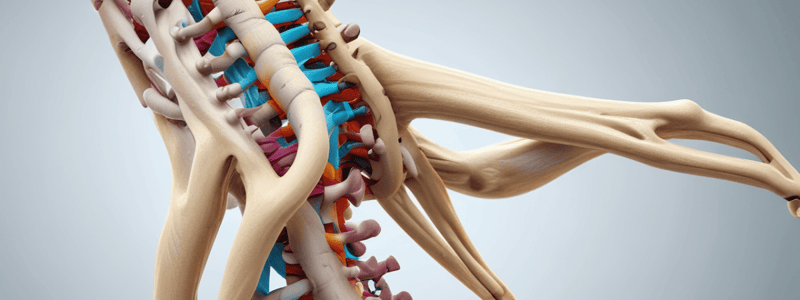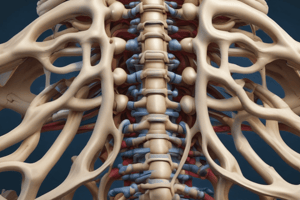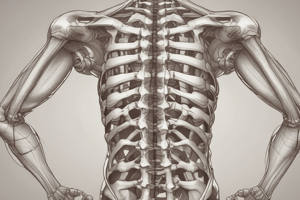Podcast
Questions and Answers
Bending Compression Bending only causes compression on the structures of the spine.
Bending Compression Bending only causes compression on the structures of the spine.
False (B)
In forward flexion, the posterior structures are subjected to tension.
In forward flexion, the posterior structures are subjected to tension.
False (B)
Tensile forces in the posterior outer anulus fibrosus help to limit motion in flexion.
Tensile forces in the posterior outer anulus fibrosus help to limit motion in flexion.
True (A)
In extension, the anterior structures are unloaded.
In extension, the anterior structures are unloaded.
In lateral bending, the ipsilateral side of the disk is stretched.
In lateral bending, the ipsilateral side of the disk is stretched.
Prolonged forces result in mechanical changes in the disk.
Prolonged forces result in mechanical changes in the disk.
Resistance to extension is provided by passive tension in the posterior longitudinal ligament.
Resistance to extension is provided by passive tension in the posterior longitudinal ligament.
The mobile segment of the vertebral spine includes the intervertebral disc, intervertebral foramen, and ligamentum flavum.
The mobile segment of the vertebral spine includes the intervertebral disc, intervertebral foramen, and ligamentum flavum.
Each vertebra in the vertebral motion system forms a second-class lever where the articular process acts as the fulcrum.
Each vertebra in the vertebral motion system forms a second-class lever where the articular process acts as the fulcrum.
The interbody joints allow movements such as gliding, distraction, compression, and rotation.
The interbody joints allow movements such as gliding, distraction, compression, and rotation.
The cushioning effect on the vertebral column is only passive and does not involve active mechanisms.
The cushioning effect on the vertebral column is only passive and does not involve active mechanisms.
The mobile segment is primarily responsible for the movements of the vertebral spine.
The mobile segment is primarily responsible for the movements of the vertebral spine.
The functional link between the anterior and posterior pillars is formed by the laminae.
The functional link between the anterior and posterior pillars is formed by the laminae.
The vertebrae in the vertebral motion system allow movements in all spatial directions.
The vertebrae in the vertebral motion system allow movements in all spatial directions.
The vertebral column has 6 degrees of freedom.
The vertebral column has 6 degrees of freedom.
The stiffness of the vertebral column refers to its ability to resist an applied load.
The stiffness of the vertebral column refers to its ability to resist an applied load.
The vertebral column is only subjected to axial compression during normal functional activities.
The vertebral column is only subjected to axial compression during normal functional activities.
Fluid is expressed from the nucleus pulposus and annulus fibrosus under sustained compressive loading.
Fluid is expressed from the nucleus pulposus and annulus fibrosus under sustained compressive loading.
When compressive forces are decreased, the disk imbibes fluid back from the vertebral body.
When compressive forces are decreased, the disk imbibes fluid back from the vertebral body.
The expressed fluid is absorbed through large openings in the cartilaginous end plate.
The expressed fluid is absorbed through large openings in the cartilaginous end plate.
A person is taller in the morning than in the evening due to increased axial compression during sleep.
A person is taller in the morning than in the evening due to increased axial compression during sleep.
Prolonged compressive forces cause a shift in load from the nucleus pulposus to the anulus fibrosus.
Prolonged compressive forces cause a shift in load from the nucleus pulposus to the anulus fibrosus.
Buckling or prolapse of the nucleus pulposus can occur due to increased load on the annulus fibrosus.
Buckling or prolapse of the nucleus pulposus can occur due to increased load on the annulus fibrosus.
Creep-induced elongation of supporting structures leads to increased stability of vertebral structures.
Creep-induced elongation of supporting structures leads to increased stability of vertebral structures.
Torsional forces are created during axial rotation and are part of coupled motions.
Torsional forces are created during axial rotation and are part of coupled motions.
The highest torsional stiffness is found at the lumbosacral junction.
The highest torsional stiffness is found at the lumbosacral junction.
Torsional stiffness is provided mainly by the inner layers of vertebral bodies and intervertebral disks.
Torsional stiffness is provided mainly by the inner layers of vertebral bodies and intervertebral disks.
In torsion, all annulus fibrosus fibers resist clockwise rotations.
In torsion, all annulus fibrosus fibers resist clockwise rotations.
The lumbar region has the most effective structure for resisting torsion due to its unique anatomy.
The lumbar region has the most effective structure for resisting torsion due to its unique anatomy.
Rupture of disk fibers is more likely to occur when torsion, heavy axial compression, and bending are combined.
Rupture of disk fibers is more likely to occur when torsion, heavy axial compression, and bending are combined.
Vertebral structures are not at risk of injury when exposed to creep-induced elongation.
Vertebral structures are not at risk of injury when exposed to creep-induced elongation.
Flashcards are hidden until you start studying




